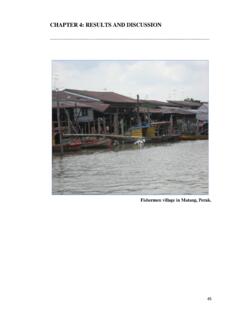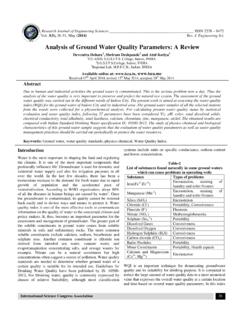Transcription of PHYSICO-CHEMICAL PARAMETERS FOR TESTING OF WATER …
1 Available Online through (or) IJPBS |Volume 3| Issue 3 |JUL-SEPT|2013|523-527 Review Article Biological Sciences International Journal of Pharmacy and Biological Sciences (e-ISSN: 2230-7605) Varsha Nigam* et al Int J Pharm Bio Sci or Page523 PHYSICO-CHEMICAL PARAMETERS FOR TESTING OF WATER - A REVIEW 1*Varsha Nigam, 1 Neelam Behl, 2 Kanchan 1*Dept. of Botany, Guru Nanak Khalsa College,Yamuna Nagar 13500 (Haryana) INDIA 1 Dept. Of Zoology, Guru Nanak Khalsa College, Yamuna Nagar- 135001, Haryana, INDIA 2 Principal, Guru Harkishan Degree College, Jhansi- 488002 ( ) INDIA *Corresponding Author Email: ABSTRACT Due to increase population, advanced agricultural practices, industrialization, man- made activity, WATER is being highly polluted with different contaminants.
2 WATER is a vital resource for human survival. The availability of good quality WATER is an indispensable feature for preventing diseases and improving quality of life. It is necessary to know details about different PHYSICO-CHEMICAL PARAMETERS such as colour, pH, temperature, Electrical conductivity, Total Carbon di oxide, chloride contents, carbonate contents, bicarbonate contents, Total hardness, Dissolved Oxygen (DO), Biological oxygen Demand (BOD), chemical Oxygen Demand (COD), Total alkalinity used for TESTING of WATER quality . Standards prescribed by World Health Organization (WHO) and Bureau of Indian Standard (BIS) for different PHYSICO-CHEMICAL PARAMETERS also have been given for comparing the value of real WATER sample.
3 KEY WORDS PHYSICO-CHEMICAL PARAMETERS , Electrical conductivity, BOD, COD, WHO, BIS. INTRODUCTION WATER pollution is a serious problem in India as almost 70 per cent of its surface WATER resources and a growing percentage of its groundwater reserves are contaminated by biological, toxic, organic, and inorganic pollutants. In many cases, these sources have been rendered unsafe for human consumption as well as for other activities, such as irrigation and industrial needs. This shows that degraded WATER quality can contribute to WATER scarcity as it limits its availability for both human use and for the Due to growth of population, agriculture, and industries, demand for domestic WATER has increased many times during the last few years.
4 Improper waste disposal and over exploitation of resources has affected the quality , not only of tap WATER but also of ground Man for its expanding needs of food, shelter, energy etc. has exploited the natural resources at an uncontrolled rate as a result annual rainfall has declined from 3-4%. Denuded land does not soak much WATER as a result most of the rainfall is running waste , less WATER is being stored in underground aquifer which are vital for maintaining river flow s in dry season and other usages. WATER plays very vital role in the development of any city or urban centre. As one knows, with the growth of the city, the number of dwelling houses increases, the number of various businesses goes up; it results in to the migration of people from the rural areas to the urban areas for seeking jobs and earning fortunes.
5 As a result of it the population of that area increases immensely. The increased number of people require lot of fresh WATER , basically for the drinking or consumption purpose. 3 WATER pollution has many sources. The most polluting of them are the city sewage and industrial waste discharged into the rivers. The facilities to treat waste WATER are not adequate in any city in India. Presently, only about 10% of the waste WATER generated is treated; the rest is discharged as it is into our WATER bodies. Due to this, pollutants enter groundwater, rivers, and other WATER bodies. Such WATER , which Available Online through (or) IJPBS |Volume 3| Issue 3|JUL-SEPT|2013|523-527 International Journal of Pharmacy and Biological Sciences (e-ISSN: 2230-7605) Varsha Nigam* et al Int J Pharm Bio Sci or Page524 ultimately ends up in our households, is often highly contaminated and carries disease-causing microbes.
6 Agricultural run-off, or the WATER from the fields that drains into rivers, is another major WATER pollutant as it contains fertilizers and pesticides. Fertilizers have an indirect adverse impact on WATER resources. Indeed, by increasing the nutritional content of WATER courses, fertilizers allow organisms to proliferate. These organisms may be disease vectors or algae. The proliferation of algae may slow the flow in WATER courses, thus increasing the proliferation of organisms and sedimentation. The use of land for agriculture and the practices followed in cultivation greatly affect the quality of groundwater. Intensive cultivation of crops causes chemicals from fertilizers ( nitrate) and pesticides to seep into the groundwater, a process commonly known as leaching.
7 Routine applications of fertilizers and pesticides for agriculture and indiscriminate disposal of industrial and domestic wastes are increasingly being recognized as significant sources of WATER pollution. Therefore it is necessary that the quality of drinking WATER should be checked at regular time interval, because due to use of contaminated drinking WATER , human population suffers from various WATER borne WATER is not only an essential element for survival of life but also it is an important vehicle for economic development of the nation. Though WATER is a renewable resource the volume of usable WATER is limited in the nature. So it is essential to maintain the sustainability of WATER by adopting proper management technique in its utilization (Panjiar, 2010).
8 5 The Central Pollution Control Board monitoring results obtained during 2005 indicate that organic pollution continues to be predominant in aquatic resources. Organic pollution measured in terms of bio- chemical oxygen demand (BOD) and coliform count gives an indication of the extent of WATER quality degradation in different parts of the country. It was observed that nearly 66 per cent of the samples had BOD values less than acceptable limits while 44 per cent of the samples indicated the presence of coliform while according to the BIS there should be no coliform in drinking WATER samples. PHYSICO-CHEMICAL PARAMETERS :- The availability of good quality WATER is an indispensable feature for preventing diseases and improving quality of life.
9 It is necessary to know details about different PHYSICO-CHEMICAL PARAMETERS such as color, temperature, acidity, hardness, pH, sulphate, chloride, DO, BOD, COD, alkalinity used for TESTING of WATER quality . Some physical test should be performed for TESTING of its physical appearance such as temperature, color, odour, pH, turbidity, while chemical tests should be perform for its BOD, COD, dissolved oxygen, alkalinity, hardness and other Being a basic need of human development, health and well being, safe drinking WATER is an internationally accepted human right (WHO, 2001), which has been enlisted as one of the ten targets in the Millennium Development Goals (MDGs).6 Temperature:- Temperature effects the seasonal and diurnal variation.
10 It controls the rate of all biochemical and biological reactions including growth, multiplication, decay, mineralization, production etc. Temperature is recorded with the help of maximum minimum Electrical conductivity:- Ground WATER quality is measured by the method of electrical conductivity. As the salt is more conducive of electricity and if there is more amount of salt in a fixed volume of WATER the electrical conductivity of the WATER will be more in comparison to less saline The ability of a solution to conduct an electrical current is governed by the migration of solutions and is dependent on the nature and numbers of the ionic species in that solution. This property is called electrical conductivity.






